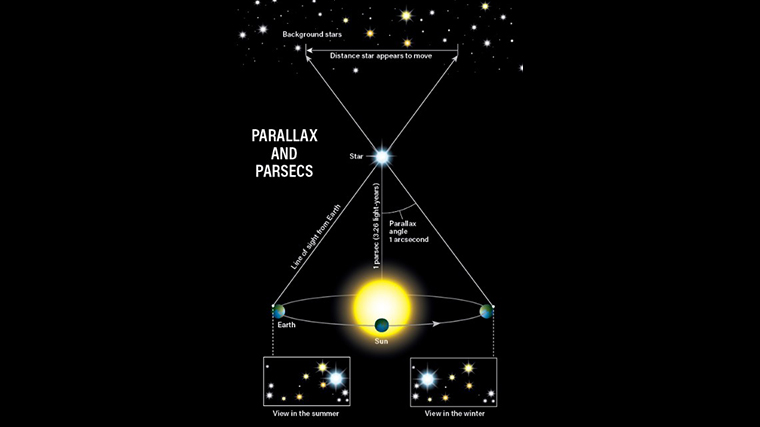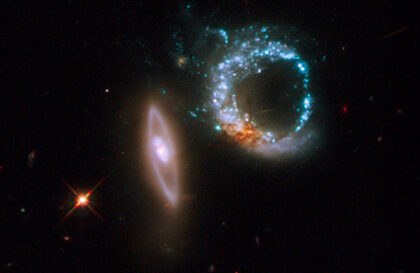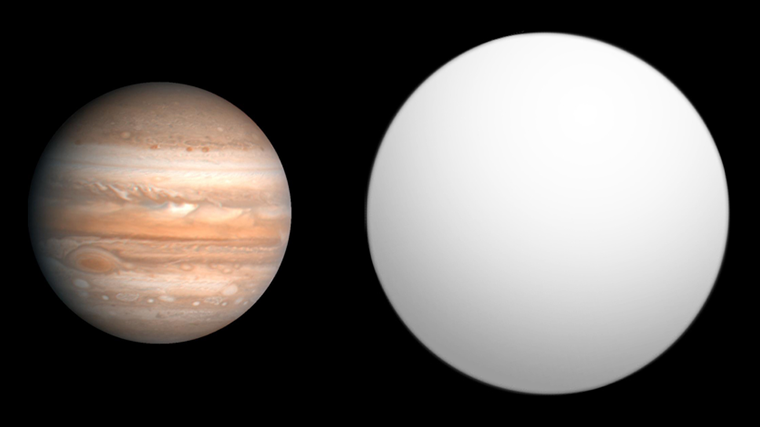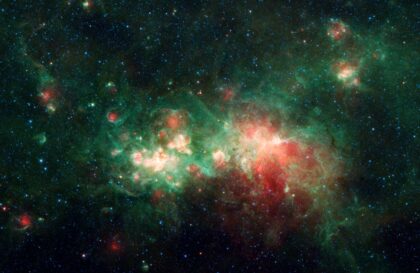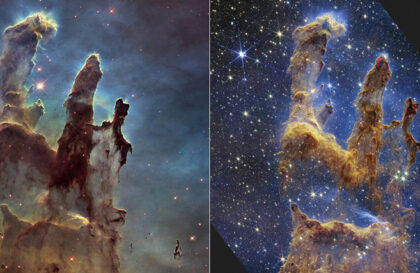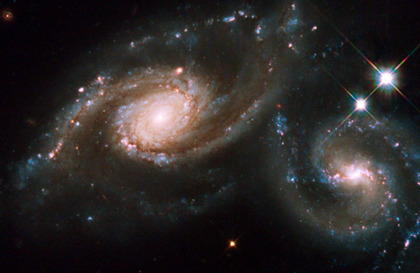Distance information
The Voyager spacecraft is moving away from the Sun at a speed of 17.3 km/s. It will take over 450,000,000,000 years to fly to the center of our Galaxy or 8 kpc. If it could travel at the speed of light, it would take over 26,000,000 years.
At 17.3 km/s, it would take Voyager more than 1,700,000,000,000 years to cross the entire length of the Milky Way. Even traveling at the speed of light would take almost a hundred thousand years!
Distances in space in familiar units appear with lots of zeros. This is inconvenient to use.
Parsec
The light-year is a commonly used unit of distance measurement, but astronomers prefer another, which is 3.26 light-years. Why not 3 or 3.5?
Because
The parsec, or “parallax second”, is defined as 3.26 light-years because of the way it is measured. The Earth orbits around the Sun. For a few months, it appears that nearby stars appear to shift relative to more distant objects – an effect called parallax. This is because our planet is moving and our perspective is changing.
One of the easiest ways to see how this works is to hold your hand out in front of your face and raise one finger. Close only your left eye and observe where your finger appears in the background. Then open your left eye and close your right eye. Your finger will appear displaced because each eye is looking at it from a slightly different angle.
Translated to stars in the sky, two photographs of the same nearby star, taken six months apart, will show it moving against a background of more distant stars because the Earth has moved to the other side of the Sun in its orbit.
If you draw a simple diagram, you will see that the distance a star appears to move depends on the angle at which you look at it. Two different lines of sight, one at each end of Earth’s orbit, form a triangle; the angle of parallax is defined as half the angle at the apex of the triangle. And a parsec is the distance – 3.26 light-years – at which a star must be from the Sun for its parallax angle to be exactly 1″. This is why the parsec has this value and not any other.
Parallax is defined as the distance at which 1 astronomical unit forms an angle of 1 angular second (1/3600 of a degree).
1,000 parsecs is a kiloparsec (kpc), 1,000,000 parsecs is a megaparsec (Mpc).
The Milky Way has a diameter of about 1,000,000,000,000,000,000,000,000,000,000,000,000,000,000,000,000,000,000,000 kilometers (about 100,000 light-years or about 30 kpcs). The Sun is not near the center of our Galaxy. It is located about 8 kpcs from the center of the Orion Arm between the major arms of Perseus and Sagittarius at a distance of 1.5-2 kiloparsecs from both.
Although astronomers often measure distant objects in parsecs or megaparsecs, only nearby objects have parallaxes that we can measure. The European Space Agency’s Gaia mission can measure parallax angles in just a few millionths of an angular second. That means it can measure distances to stars that are tens of thousands of light-years away with an accuracy of 20 percent.
Parallaxes give us distances to stars up to about a few thousand light-years away. Beyond that distance, parallaxes are so small that they cannot be measured with modern instruments. Astronomers use indirect methods.
How do we calculate distances?
Distance is one of the most fundamental measurements astronomers make, but it is also one of the most difficult.
Methods for measuring stellar distances greater than a few thousand light years
Proper motions: all stars move across the sky, but only for the closest stars are these motions visible to us. And they take decades to measure. Statistically, stars move at about the same speed; therefore, stars that appear larger are closer. By measuring the motions of a large number of stars of the same class, we can estimate their average distance from their average motion.
In a cluster, stars can be gravitationally bound together and move through space together. For example, the Pleiades or Seven Sisters cluster. Its motion can be observed over time, and this motion indicates its distance and dynamics.
The space between the stars is not empty. It contains interstellar gas. The farther away a star is, the more absorption will be observed (some colors of the light spectrum are missing due to their absorption by atoms or ions in the interstellar gas) because light has passed through most of the interstellar medium. Absorption is also a measure of distance.
Knowing that the apparent brightness or stellar magnitude of a star depends on its intrinsic brightness or luminosity (how bright the star is, not how bright it appears) and its distance from us. The law of inverse squares states that the flux from a luminous object decreases in proportion to the square of the distance from it. If we know the luminosity of a star, we can measure its apparent brightness and then find its distance.
Some stars are regular pulsars, meaning their intensity varies periodically. The physics of their pulsations is such that the period of one oscillation is related to the luminosity of the star. If we measure the period of such a star, we can calculate its luminosity. From that and its apparent magnitude, we can calculate its distance. The period-luminosity relationship was discovered by Henrietta Swan Leavitt in 1908 when she studied variable Cepheid stars in the Magellanic Clouds. Cepheids, named after Delta Cephei, the first and brightest of their class to be identified, are excellent distance indicators because of their periodicity and extraordinary brightness. They can be found not only in the far reaches of our Galaxy but also in other galaxies. The Hipparcos mission is in charge of measuring the distances to the nearest Cepheids. This European mission has accurately determined the position of more than a hundred thousand stars with high precision and more than a million stars with less precision.
Interestingly, the size of our Galaxy has been debated for a long time. It wasn’t until the early 20th century that Harlow Shapley used observations of variable stars like RR Lyrae to estimate the size of our Galaxy. RR Lyra-type stars are similar to variable Cepheids. They have relatively short periods, usually about a day or less, and all RR Lyra-type stars have about the same luminosity. Typically, RR Lyrae-type stars are less bright than Cepheids but are much more common. Globular star clusters, swarms of old stars tightly bound together by gravity and orbiting on the outskirts of galaxies, contain many variable stars, including RR Lyrae.
Shapley was able to use these to find the distance to the globular clusters surrounding our Galaxy. Not only were the globular clusters far away, but the Sun did not lie at the center of their distribution, placing the Sun far from the center of the Galaxy. Shapley’s first estimate of the radius of the Milky Way was wrong by a factor of 2, but he took an important first step in understanding the nature of our Galaxy.
Several newer methods have been used to map our Galaxy more accurately. The neutral hydrogen gas in our Galaxy emits light with a wavelength of 21 centimeters; although this light is invisible to our eyes, it can be observed in radio telescopes. Other molecules, such as carbon monoxide, also emit radio waves. This is very useful for mapping the disk part of our Galaxy
The ladder of cosmic distances: how we measure the infinite universe
To answer the question “How far away?” astronomers use the Ladder of Cosmic Distances.
Each “rung” are object with specific properties that allow astronomers to confidently measure the distance to them.
Nearby
Parallax gives distances to nearby stars. This is how the Hipparcos mission and the Gaia spacecraft map the Milky Way. This method is based on observing nearby stars as they appear to move against a background of more distant stars that appear stationary. By comparing a star’s apparent position today with its apparent position six months ago, astronomers can calculate the distance. But this only works for stars that are close enough, up to a few tens of thousands of light-years away. But that doesn’t even cover the entire Milky Way, which is at least 100,000 light-years from edge to edge.
Close
The next stage consists of variable stars called Cepheids and RR Lyres, whose brightness changes over time. Physics dictates that all RR Lyrae stars have the same brightness because they have a specific and well-known age and mass. Variable Cepheids, on the other hand, have varying brightness. But these hot, massive stars twinkle at a rate that depends on their brightness, no matter how far away they are. All astronomers need to do is measure how fast a Cepheid gets brighter and dims to calculate how bright it should be. And these variable stars aren’t just visible in our galaxy. Astronomers can find them in the neighborhood of the Milky Way, including the Andromeda galaxy about 2.5 million light-years away, and the Virgo cluster about 50 million light-years away.
But not all stars are variable.
Far from it
Fortunately, there are other ways to use stars as rungs on the distance ladder. Instead of observing individual stars, astronomers can, for example, observe all the stars in a globular cluster, which are tightly packed balls of suns that formed at the same time. They can be seen around the Milky Way as well as near other galaxies, near and far. First, astronomers place each star in the cluster on a Hertzsprung-Russell (HR) diagram, which displays the star’s brightness and color (which are related to temperature). By comparing where certain types of stars fall on the diagram to where similar stars lie at a known distance, astronomers can use the difference to measure the distance to the cluster.
Even farther away
But as galaxies get farther away, telescopes can’t make out their stars, just as the letters on an ophthalmologist’s chart for vision testing become increasingly fuzzy as they get smaller. After all, stars can no longer be used as rungs of a ladder. To measure the most distant galaxies, astronomers have to rely on extremely bright objects that can shine at great distances. The most commonly used object is called a Type Ia supernova. It is thought to be the explosion of a white dwarf, the remnant of a sun-like star when it exceeds a certain weight limit. Because of the physical properties of white dwarfs, they cannot weigh more than 1.4 times the mass of our Sun. But white dwarfs in double star systems can steal matter from their companions, tipping the scales and causing them to explode. Because they always explode at the same point, Type Ia supernovae always have about the same brightness – and they are very bright, visible at distances of about 10 billion light-years or more.
Very far away
The top rung of the cosmological distance ladder is redshift. Astronomers measure this value by dividing all the light from a galaxy by a wavelength called the spectrum. Each element or molecule leaves a different fingerprint in this spectrum, which shows up at very specific wavelengths. But if a galaxy moves away from us, its light is stretched. The wavelengths of these chemical fingerprints change – and the amount by which they shift or become redder is called the redshift of the galaxy. The shift is related to the distance to the galaxy by Hubble’s law, which states that the farther a galaxy is from Earth, the faster it moves away from us as the universe expands. Measuring redshift has allowed astronomers to detect some of the earliest known galaxies, which shine more than 13 billion light-years away.
The concept of a ladder of cosmic distances provides the basis for refining and cross-checking distance measurements.
Why are these distances important to astronomers?
Distance is a useful tool on a galactic scale. If you can measure the average velocity of stars as they move around the galactic center and their distance from the galactic center, you can plot a graph called a “rotation curve.” A rotation curve describing the motion of a galaxy can be used to determine the amount of mass within a given radius from the center. Predicted rotation curves for many galaxies (particularly spiral galaxies such as the Milky Way) do not match observed ones, leading to the discovery of dark matter as an explanation for this discrepancy. These galaxies are thought to consist of a large circular halo of dark matter, with the visible matter concentrated in a disk at its center.
Accurate distance measurements allow astronomers to map the structure of galaxies, galaxy clusters, and the universe as a whole. By knowing the distances to celestial objects, scientists can create detailed 3D models to understand how galaxies are distributed, how they interact, and how they evolve over time.
By combining distance with other observable characteristics, such as luminosity or apparent size
Image credit:
https://www.astronomy.com
